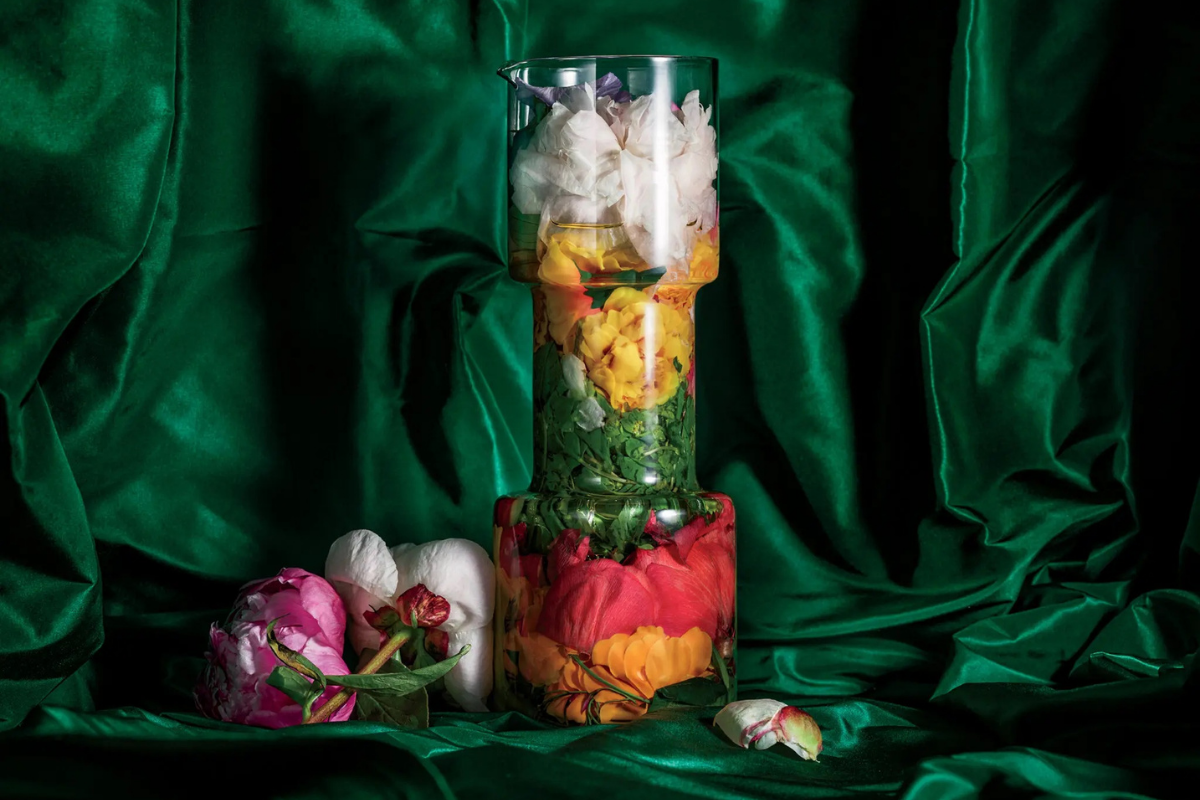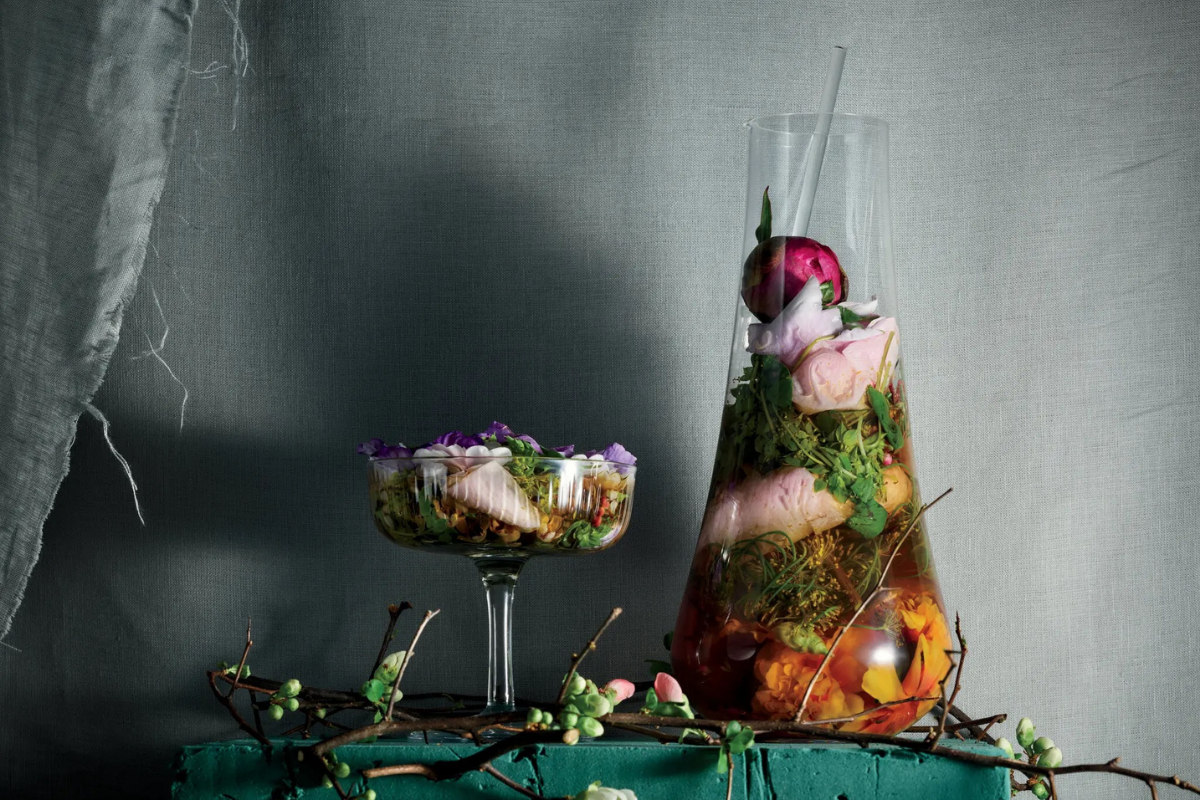All is dark as the bartender slides across a peach-coloured cocktail balanced on a slim glass stem — a Lauren Bacall of a drink. There’s something called a buzz bud, a little furled blossom, on top. I sip and taste notes of lemon and honey. Then, as instructed, I eat the tiny bud, and something strange happens: my mouth feels shivery, almost numb. It’s disconcerting. Acmella oleracea, also known as buzz buttons or electric daisies, are known for their potent tingling effect. I’m not sure I like it. I’m not sure that’s even the point. When I take the next sip, the cocktail seems altered, almost pixelated — like shifting from animation to high-definition. I taste the drink more clearly and cleanly. Lemon. Honey. All of it melted into a near-buttery dissolution.
“That’s a functional garnish,” says Chevy Farrell, the beverage director at No Man’s Land in Fort Lauderdale, Florida. Since long before the first swim-up bar plopped an orchid atop a frozen daiquiri, petals have been rimmed around glasses for visual appeal. But blossoms can add so much more: they can be sweet, earthy, umami, funky — “a flavour,” Farrell says, “that you can’t put your finger on. It’s the mystery that takes it higher.”

Flowers are transporting: magical agents that attend our great transitions, from weddings to funerals; symbols of purity and fresh starts. We collect them, wear them, crush their fragrance against our wrists and necks. They elevate our rituals and communicate love and grief. They’re the bridge between body and spirit, heaven and earth.
And there is something transgressive about drinking them: it’s extravagant and excessive — an echo of Nero’s peeled grapes. Perhaps it’s slightly offensive in a world in which there is so much deprivation. It’s too much. Yet a world such as ours hankers for too much because one response to suffering is to smother oneself in beautiful forgetting, to become a lotus-eater, a drinker of nepenthe — the magical drug of forgetfulness referenced in Homer’s “Odyssey” — which the first-century Roman writer Pliny the Elder believed was made of borage. In this sense, blossoms signify not only pleasure but healing. No wonder they’ve long been used as ancient remedies.
Take hibiscus, which now appears in everything from ginger beers to infused waters. My Jordanian aunties added sugar, lime and toasted pine nuts to their karkade (hibiscus) tea, which aids digestion. The flower’s jewel-toned petals have always been especially popular in Mexico, in preparations from agua de Jamaica to aromatic mole. Ruby Hibiscus Water, a bottled beverage made in New York, conveys the plant’s signature tartness, in a richer, more berrylike brew. Noah Wunsch, the company’s founder, was looking for something to help him curb sugar cravings when he learned about the benefits of hibiscus tea. It seems counterintuitive to think that something sour would counteract the desire for sweetness, but that’s one of the shape-shifting qualities of flowers.
On TikTok, young people freeze nasturtiums, pansies and geraniums into ice cubes, which melt colourfully into spritzes; others are reviving the ancient Chinese tradition of rolling green tea leaves into jasmine-scented pearls, which bloom in hot water. For centuries, rosewater and orange blossom water have infused syrups, candies and pastries, from England to Iran. A recipe featuring borage in Alyson Brown’s “The Flower-Infused Cocktail” (2021) mentions John Gerard’s 1597 book, “The Herball or Generall Historie of Plantes”, which claims that syrup made of the plant “comforteth the hart, purgeth melancholie, quieteth the phrenticke or lunaticke person”. Violets were popular with ancient Romans, who, Brown says, wove them into wreaths to ward off hangovers.
Flowers may never become as commonplace in drinks as fruits or herbs, but their exotic nature is part of their appeal. Teri Gelber, the owner of T Project, an organic tea studio in Portland, Oregon, frequently includes lavender, linden and Oregon cherry blossom in her blends but advises a judicious balance, so as “not to overwhelm the other flavours”. It’s true, some recent experiments of this ilk from other purveyors aren’t all chardonnay and roses: a wine infused with marigold tastes thin and slightly vomitous; a cornflower tea is reminiscent of peat moss. Using flowers this way requires care and luck. Chefs must respect their “element of surprise”, as Gelber puts it.
But when life on Earth feels too heavy, the moon and stars beckon. We want lightness and escape. Enchanting and wild, flowers take us out of ourselves: they’re familiar yet unearthly, and to drink them is to touch the ground and to be lifted, body and soul.




 A champagne coupe full of peony, cherry blossom, linden, verbena and violet next to a pitcher stuffed with marigold, hibiscus, linden, peony, verbena and cherry blossom, which is also arrayed on the base. Photography by Anthony Cotsifas.
A champagne coupe full of peony, cherry blossom, linden, verbena and violet next to a pitcher stuffed with marigold, hibiscus, linden, peony, verbena and cherry blossom, which is also arrayed on the base. Photography by Anthony Cotsifas.